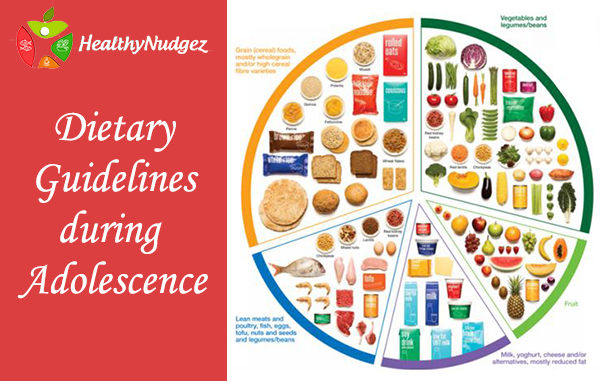Dietary Guidelines during Adolescence
Adolescence is the time when a lot of developmental changes happen, both physical and mental , which may cause a change in the food habits and choices. Also, the adolescent child is more independent, so, (s)he would like to make her/his own food choices. Parents will have to help the adolescent plan a healthy diet which would provide enough calories and protein to facilitate his growth and development along with a routine of regular physical activity.
Points to be kept in mind while planning an adolescent’s diet are:
- Parents need to ensure that enough foods from all food groups, that is cereals, pulses and meats, milk and milk products, fruits and vegetables, nuts, fats and sugars are included in the daily diet plan of an adolescent. The child has to be encouraged to choose from a variety of foods.
- Protein, calcium and Iron are the major nutrients of concern during this period.
- An adolescent should eat 3 main meals and 2 to 3 snacks each day to help meet his caloric needs. He should also eat a variety of healthy foods to get the nutrients he needs, and to maintain a healthy weight. The child may need parental help to plan his/her meals and snacks.
- Sufficient amount of good quality proteins need to be included in an adolescent’s diet. Foods that provide good protein are lean meats, poultry, fish, and dairy products (milk, cottage cheese, curd and eggs). Other healthy protein foods include legumes (such as pulses, beans), soy foods (such as tofu, soy milk, soy curd), and peanut butter.
- Encourage the child to get enough calcium each day. Calcium is needed to build strong bones. Children who are 9 to 18 years old need 1300 milligrams (mg) of calcium each day. To get enough calcium, children should eat foods high in calcium. Good sources of calcium are low-fat dairy foods (milk, cheese, yogurt, eggs). Other foods that contain calcium include coconut, almonds, nuts and green leafy vegetables.
- Children at this age need comparatively more iron in order have sufficient iron pools in the body. This may cause many health related problems and also anemia which can affect the child’s growth and ability to learn. Iron is found in red meat, egg yolks, whole grains and fortified cereals and breads.
- Adolescents should be provided a variety of fruits and vegetables. Half of child’s plate should contain fruits and vegetables. Give fresh fruits instead of fruit juice as often as possible.
- More quantities of dark green, red, and orange vegetables and fruits should be included in their diet. Dark green vegetables include broccoli, spinach, mustard greens. Examples of orange and red vegetables are carrots, pumpkin, papaya, mangoes, oranges, sweet potatoes, and red peppers.
- Their diet should include more of whole grains as compared to refined grains . Whole grains include brown rice, whole wheat pasta, whole wheat flour, oats and ragi.
- Good amount of dairy foods should be part of an adolescent’s daily diet. Dairy foods are a good source of calcium. These include milk, cheese, cottage cheese, and curd ( yogurt).
- Use healthy fats to prepare foods. Unsaturated fat is a healthy fat. It is found in foods such as soybean, canola, olive, and sunflower oils. Limit unhealthy trans fat, and cholesterol. These are found in shortening, margarine, and animal fat. Use baking, roasting, toasting or grilling as cooking methods instead of frying foods to reduce the amount of fat.
- Other foods that the child should limit are foods that are high in fat and sugar, as these do not have the nutrients required for good health. Foods high in fat and sugar include potato chips, cakes and pastries, candy, chocolates and other sweets, juice, fruit drinks, and soda (carbonated beverages). If the child eats these foods too often, he may eat fewer healthy foods during mealtimes. He may also gain too much weight.
- Caffeine is found in soft drinks, energy drinks, tea, coffee, and some over-the-counter medicines. The child should limit his intake of caffeine as it can cause the child to feel jittery, anxious, or dizzy. It can also cause headaches and trouble sleeping.
- Children at this age need to include plenty of water and liquids in their daily diet. These include soups, lemon juice, fruit juices and milk.
Free Consultation with Best Nutritionist in Delhi

